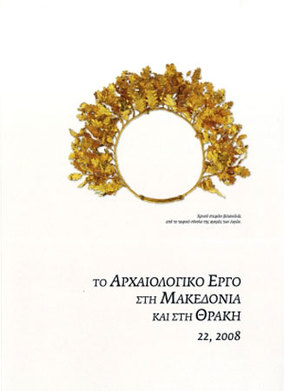Πανεπιστημιακή ανασκαφή Φιλίππων 1988-1996
Part of : Το Αρχαιολογικό Έργο στη Μακεδονία και στη Θράκη ; Vol.10, No.Β, 1996, pages 719-733
Issue:
Pages:
719-733
Parallel Title:
The university excavation at Philippi
Abstract:
During the nine years which have elapsed since the excavation began, an area of 4,300 square metres to the east of the Octagon and the so-called Bishopric. The fourth insula has been uncovered, entirely occupied by a re sidence with an area of some 1,400 square metres, together with the greater part of a smaller insula, the fifth, which has not been fully explored because of the farm road which passes across its east section. Between the two insulae, a cardo was discovered linking the Via Egnatia with the Diagonal Road which were the two main streets of Philippi and converged near the Neapolis Gate. Part of another cardo at right angles to the Diagonal Road has also been excavated, along with sections of the insulae on either side of it, which were occupied by workshops and shops in the upper strata.The first Christian phase of inhabitation of Insula 4 dates from the first half of the fourth century. The greater part of the house had two storeys, with a colonnade on the Via Egnatia side. The principal rooms, and the lives of the household, were organised around the small atrium in the north part of the house and the larger hall with four double rows of Ionic columns on the south. In about the middle of the fifth century (or somewhat later), the house was extended to include the area of the north colonnade, being divided into two households with the construction of a new kitchen and lavatories in the NE corner. Major changes were made in the sixth and seventh centuries: a) the rows of columns in the large atrium were built into a wall, a residence was constructed on the upper storey, the ground floor level was raised, and a large wine-vat was constructed on its south side; b) the room with the tribellum and the men’s quarters on the north side were converted into storerooms, with many jars, and c) the large three-couch dining-room became an unroofed area with a fountain.A severe earthquake early in the seventh century caused extensive damage to the public buildings and private houses. The public structures were repaired, but most of the houses in the lower part of town had to be abandoned. Two smaller houses were built on Insula 4, and survived until the late ninth or early tenth century.Insula 5 was organised in a different manner, and must have been founded around the middle of the fifth century. It is made up of three units. Two of these are on the west side. The unit closest to the Via Egnatia consists of two self-contained workshops-shops buildings. That on the side of the Diagonal Road is occupied by a relatively small house with working and storage areas arranged around a rudimentary impluvium in which a metal boiler was in stalled at a later date. The living areas must have been on the upper floor. Only a small part of the ground floor of the third unit has been excavated, yielding storage rooms, service areas and a double-ended corridor accessible from both the Via Egnatia and the Diagonal Road.The two insulae on the south side of the Diagonal Road, which had a colonnade on their north facades, consisted of shops and workshops of roughly equal size. The two corner shops, on the east and west sides of the cardo, are alike in being much larger than the others. The shop/workshops of the east insula, with only one room each, originally had a colonnade on their south side, too, but this was walled up and incorporated into the shops at some time (probably during the fifth century). To date, excavations in the west insula have yielded a glass-maker’s shop dating back to the fourth century and pro bably still operating in the first half of the seventh. Further to the south, work has begun on the excavation of a large circular kiln whose purpose is as yet un known. The workshops of this insula were located in the rooms of an important building with mosaic floors.
Subject:
Subject (LC):
Keywords:
Φίλιπποι




